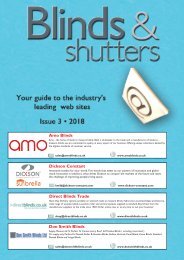Finishing - September-October 2020
Create successful ePaper yourself
Turn your PDF publications into a flip-book with our unique Google optimized e-Paper software.
14 POWDER COATING
• Do final dimensioning for the required
finish and sizing
Selective plating equipment is portable,
enabling the operator to meet plating and
build-up requirements wherever they arise.
This flexibility is an important cost and time
saver. It minimizes dismantling, downtime,
turnaround delays and shipping charges
usually associated with sending parts out to be
plated.
Automotive Case History
Vehicle manufacturers around the world
continue to increase the use of fiber reinforced
plastic (FRP) components in their cars to
reduce weight, cost and fuel consumption.
Several kinds of fiber and plastic matrixes are
being used in compression and resin transfer
molding (RTM) processes for everything from
body parts to internal components. Carbon
fiber reinforced plastic (CFRP) components
seem to be the choice for many of the body
parts in small, lightweight vehicles. The molds
for these and other FRP parts can be quite
expensive and have long lead times, especially
for the car body parts.
That was the case for one automaker having
problems with a fender mould that was being
used over multiple shifts every day. The
original cost for this mould was approaching
$2 million and was made by an offshore
producer. Because of pitting in an area of
several square inches at the bottom of the
mould, the automaker’s scrap rate was 15 %
and other fenders required post-processing
rework to salvage them. Compared to average
scrap rates of 2 to 4 % for other molded parts,
this was totally unacceptable.
This automaker used an outside shop for
mould maintenance. The maintenance
company tried doing some surface repairs, but
that made the problem worse. Another option
was taking the mould out of service for a
month to do major outside repairs by the
original mould maker. That meant they would
have to stockpile 800-900 fenders in a rented
warehouse—another costly alternative.
At this point the mould maintenance vendor
called in a plating technician to use the SIFCO
Process of selective plating to repair the
mould. The technician arrived at the site with
all the equipment and solutions needed to
complete their part of the repair. After
prepping the pitted area, copper was used as
the fill material. Afterward, a nickel cap was
applied. The final dressing back of the
repaired area to blend with the original mould
surface was then done by the mould
maintenance company.
This entire job was accomplished during
only one operating shift. The selective plating
portion of the repair was completed for less
than $10,000. The mould is now producing
fenders with scrap rates within the
automaker’s acceptable range. All this was
accomplished at a cost far below any of the
other alternatives.
Selective Plating Capabilities
Selective plating, also referred to as brush
plating, techniques were first developed in the
late 1930s, but have been refined with more
modern plating materials and equipment
today. Dozens of pure metal and alloy
solutions are available for use in brush plating
Table 1: Example of Brush Plating Applications for Plastic Molds
to accommodate different mould metals and
finishes. These solutions typically have higher
metal content than those used in tank plating.
Deposits can be produced that are hard, fine
grained, very low in porosity, have low
residual stress and are not prone to hydrogen
embrittlement. Electropolishing and application
of wear-resistant coatings to the mould surface
can also be accomplished using the same
techniques.
The preparatory process used depends on
the base material of the mould and any
plating from prior processing that may be
present. This process can include solutions for
cleaning, etching, desmutting, activating and
preplating. In all cases, preparatory and plating
solutions are applied with a handheld plating
tool wrapped with an absorbent cover material
saturated with the solution. The mould is
attached to the ground lead of a DC power
supply, and the plating tool is connected to
the positive lead to complete the circuit.
As shown in Table 1, selective plating can
solve various mould problems. Nickel and
cobalt are excellent choices for selective
deposition to resize core pins and bushings,
often without post machining. These two
materials have good toughness characteristics,
in addition to excellent wear resistance. If a
harder surface is required, nickel-tungsten,
cobalt-nickel and cobalt-tungsten alloys may
be selectively deposited with a hardness range
of Rockwell C 47 to 60.
Summary
Selective plating is a cost-effective mould
repair technique for a broad array of mould
surfaces. It can be accomplished without
removing the mould from production
machinery and can often be accomplished in a
matter of hours.
Application Metal Deposited Capping Metal
Mould Cavity Damage Nickel or Copper fill Nickel Semi-bright, Nickel-
Flash Correction in Gate
Areas or Parting Lines
Resize Core Pins and
Bushings
Corrosion Protection
Machine Maintenance
a) Hydraulic cylinder repairs
b) Resizing shafts, journal
areas, and bearing fits
Same as above
Nickel or Cobalt
Depending on corrosion
mechanism
Copper
Nickel or Cobalt
Tungsten, or Nickel alloys
Gate Areas: same as above
Parting Line: Nickel Semibright
only
Not Applicable
Not Applicable
Nickel semi bright tin or zinc
Finishing - September/October2020

















